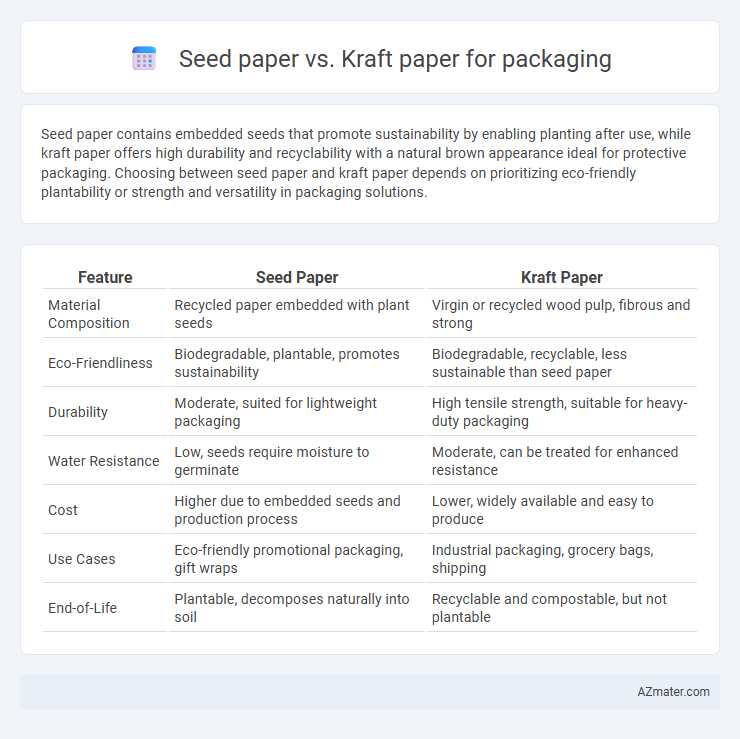Seed paper contains embedded seeds that promote sustainability by enabling planting after use, while kraft paper offers high durability and recyclability with a natural brown appearance ideal for protective packaging. Choosing between seed paper and kraft paper depends on prioritizing eco-friendly plantability or strength and versatility in packaging solutions.
Table of Comparison
| Feature | Seed Paper | Kraft Paper |
|---|---|---|
| Material Composition | Recycled paper embedded with plant seeds | Virgin or recycled wood pulp, fibrous and strong |
| Eco-Friendliness | Biodegradable, plantable, promotes sustainability | Biodegradable, recyclable, less sustainable than seed paper |
| Durability | Moderate, suited for lightweight packaging | High tensile strength, suitable for heavy-duty packaging |
| Water Resistance | Low, seeds require moisture to germinate | Moderate, can be treated for enhanced resistance |
| Cost | Higher due to embedded seeds and production process | Lower, widely available and easy to produce |
| Use Cases | Eco-friendly promotional packaging, gift wraps | Industrial packaging, grocery bags, shipping |
| End-of-Life | Plantable, decomposes naturally into soil | Recyclable and compostable, but not plantable |
Introduction to Sustainable Packaging Solutions
Seed paper integrates biodegradable fibers embedded with plant seeds, promoting zero waste and eco-friendly packaging solutions ideal for environmental sustainability. Kraft paper is made from natural wood pulp through the kraft process, offering high strength, recyclability, and biodegradability, making it a popular choice for sustainable packaging. Both materials address the growing demand for eco-conscious products but differ in their environmental impact and application versatility.
What is Seed Paper?
Seed paper is an eco-friendly packaging material embedded with biodegradable seeds that can grow into plants when planted in soil. Unlike traditional Kraft paper, seed paper combines sustainability with functionality by encouraging recycling and promoting a circular economy. Its unique composition supports environmental conservation by reducing waste and fostering green initiatives in packaging solutions.
What is Kraft Paper?
Kraft paper is a durable and strong paper made from wood pulp through the kraft process, widely used in packaging due to its high tear resistance and eco-friendly properties. Its natural brown color and fibrous texture make it ideal for wrapping, cushioning, and protecting products during shipping. Compared to seed paper, which embeds seeds for planting after use, kraft paper is primarily focused on strength and recyclability rather than biodegradability into new plants.
Environmental Impact: Seed Paper vs Kraft Paper
Seed paper offers a unique environmental advantage by being biodegradable and plantable, allowing it to naturally decompose while growing plants, thus reducing waste and promoting green spaces. Kraft paper is highly recyclable and biodegradable, made from unbleached wood pulp, which minimizes chemical use and carbon footprint during production. Both materials support sustainable packaging, but seed paper's ability to transform into vegetation provides a distinct ecological benefit beyond typical recyclability.
Biodegradability and Compostability
Seed paper offers superior biodegradability and compostability compared to kraft paper, as it contains embedded seeds that naturally decompose and promote plant growth. Kraft paper, though biodegradable, breaks down slower due to its dense fiber composition and lacks inherent compostability benefits. Choosing seed paper for packaging supports sustainable waste management by enabling direct soil enrichment, whereas kraft paper primarily reduces landfill impact without enhancing soil quality.
Printing and Customization Options
Seed paper offers eco-friendly printing with biodegradable inks that enhance sustainable branding, featuring limited customization due to its textured, fibrous surface that can affect print clarity. Kraft paper provides versatile printing options including flexographic, digital, and screen printing, with high compatibility for vibrant colors and detailed designs on smooth, sturdy surfaces. Customization on kraft paper is extensive, supporting embossing, debossing, and foil stamping to create premium packaging aesthetics.
Durability and Strength Comparison
Seed paper offers moderate durability and strength suitable for light packaging but tends to be less resistant to tearing and moisture compared to kraft paper. Kraft paper, made from wood pulp with high tear resistance and tensile strength, is ideal for heavy-duty packaging requiring enhanced protection and durability. The superior fiber composition and manufacturing process of kraft paper ensure greater durability under stress, making it preferable for robust packaging applications.
Cost Considerations
Seed paper typically incurs higher production costs than kraft paper due to embedded organic materials and specialized manufacturing processes. Kraft paper offers a more economical choice for packaging, benefiting from widespread availability, lower raw material expenses, and efficient production techniques. Businesses balancing ecological appeal with budget constraints often choose kraft paper to minimize packaging costs without sacrificing durability.
Popular Use Cases for Each Material
Seed paper is widely used for eco-friendly packaging in promotional materials, wedding invitations, and gift tags where biodegradability and plantability are key selling points. Kraft paper is popular for robust shipping and grocery bags, food wrapping, and industrial packaging due to its strong, durable, and tear-resistant properties. Both materials optimize sustainability, with seed paper appealing to environmentally conscious brands and kraft paper favored for heavy-duty, cost-effective packaging solutions.
Choosing the Right Paper for Your Brand
Seed paper offers eco-friendly packaging that biodegrades and grows into plants, ideal for brands emphasizing sustainability and unique customer engagement. Kraft paper provides durability and a natural rustic appearance, making it suitable for robust protection and a classic, organic brand image. Selecting between seed paper and kraft paper depends on your brand's values, packaging needs, and customer experience goals.

Infographic: Seed paper vs Kraft paper for Packaging
 azmater.com
azmater.com